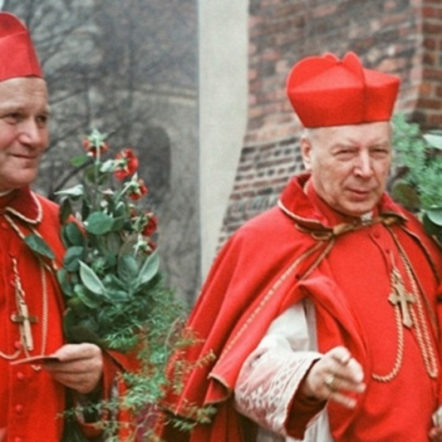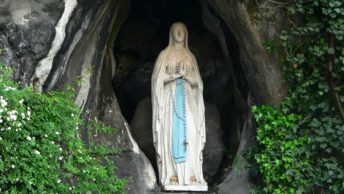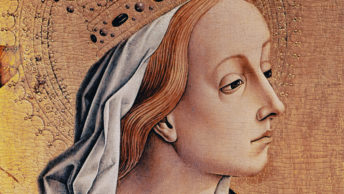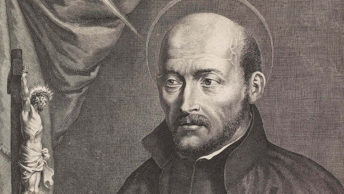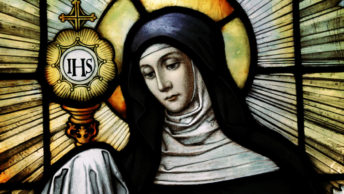“I gambled everything on Mary.”- Blessed Stefan Wyszyński
The quite recent beatification of Stefan Wyszyński made Catholic headlines around the world. Some newspapers depicted the new blessed as the “Cardinal who defied communism”, which is only partly true, failing to give account of his mystical and prophetic stance. Loving the Black Madonna of Jasna Góra more than almost anyone else, Wyszyński sought to save human souls from the loss of eternal life. His abiding love for the Mother of God, was the main driving force of all his commitment to the Church, Polish nation and beloved country. He appears as a magnificent light, one the Church needs so badly today.
The Marian dimension of Wyszyński`s life and ministry have common roots in his earliest youth. He owes his genuine worship to Our Lady to his parents. Their attitude and numerous pilgrimages to Jasna Góra and Ostra Brama (in Vilnius) shrines, the presence of miraculous icons of the Black Madonna and as well as the Mother of Mercy at home, created the foundation for veneration of the Mother of God and engraved every trait of patriotism in his soul. Likewise, the Polish victory in the Polish-Bolshevik war of 1920 which was commonly associated with the intercession of Our Lady. Intuitively, this boundless trust in Mary’s love and protection became the guiding signpost throughout his ministry.
He was only 9 when he lost his mother, Julianna. “On the same day I transferred all my love from a Mother to a Mother,” Wyszyński wrote years later in his book Pro Memoria. In this respect he bore a striking resemblance to young Carol Wojtyła, known as St. Pope John Paul II.
Stefan Wyszyński, as a student of the diocesan seminary in Włocławek was considered to be the person of very poor health. When his fellow seminarians, during the Rite of Ordination, lay prostrate on the floor of the neighboring Cathedral, young Wyszyński, because of suspicion typhoid fever, was lying alone in a hospital isolation room. Only after two months, just on his 23rd birthday he was ordained; however, Wyszyński was so weak that a sacristan had to lift him off the floor, and allegedly uttered “Father, in such a condition you rather go to a graveyard and not become a priest”. After many years of the priestly ministry Wyszyński admitted “ Since then I have had a feeling that not human strength but divine allows me to go on. ” and “The Virgin Mary saved me that time.”
Subsequently, after ordination, he took his first steps to Jasna Góra, to celebrate his first Mass and “to have Mother who will always remain, who never dies, who will stand by my Mass, as she was standing by the cross of Jesus.”
Among his first actions of a cardinal was to create a episcopal coat of arms, including a motto. He chose the words, “Soli Deo,” – (Only God) to which he added through the years “per Mariam” – “through Mary.”
There will also be quite a few Catholics for whom the term Marian “consecration” is a bit alien, something that sounds Martian rather than Marian. Nevertheless, the Primate, on December 8, 1953, being imprisoned in Stoczek Warmiński, said: ‘I consecrate my body and my soul to you (…) everything that I am and everything that I possess.” He did it after three weeks of preparation, according to the method of St. Louis-Marie Grignion de Montfort.
The Primate often revealed to the faithful a double blessed pattern: Christ and Mary claiming “The contemporary priesthood should also be a ministerial priesthood, following the example of the Handmaid of the Lord.”
Marian cult is deeply embedded in the history of the Polish nation. Jasna Góra with the miraculous icon of the Black Madonna has been deemed the rampart of Catholicism, this time, not against invading Turks, but against a toxic cultural parasite, coming from the East, that would unchecked, destroy its host. Wyszyński strongly believed that Our Lady has been given in the defense of the Polish nation.
The idea of writing the text of Jasna Góra Vows of the Polish Nation blossomed in the mind of the Primate during his imprisonment (1953-1956), though it has its origins much earlier, prior to his arrest. They are closely associated with the Vows made by King Jan Kazimierz in 1656 in the Cathedral in Lwów (Lvov) putting his country under the protection of Our Lady and declaring Her to be “Queen of the Polish Crown”. On 26 August 1956, the Vows were solemnly recited in Jasna Góra by a million pilgrims and the episcopate. Meaningfully, many white and red roses lay on the empty armchair symbolizing both the spiritual communion with the incarcerated Sheppard of the Polish nation and the urgent demand for his presence. His popularity was beyond dispute.
The Poles solemnly undertook to follow Our Lady as a model of faith and imitate her virtues. These included, amongst others, the promise of the indissolubility of Christian marriage, pro-life support, fostering Christian values among children. They pledged to do everything within their power to make of the country strongly believing men and women.
In the opinion of the eminent specialist of the subject – Dr. Ewa K. Czaczkowska, “Jasna Góra Vows played a pivotal role in preserving the faith of the Poles. The Primate intended in this way to mobilize the nation’s resistance to atheism and to preserve and deepen faith and Christian morality in personal, family and social life.”
On May 3, 1957, Cardinal Wyszyński launched another nationwide pastoral action – the “Great Novena,” a nine-year audacious, prophetic program of prayer and pilgrimage in preparation for the millennium of Poland’s “baptism” in 1966. Its aim was to strengthen the faith of people and to rebuild Christian morality. Every year was designed to a specific topic concerning the Vows, whereas the last one was dedicated particularly to Our Lady.
The novena also included a “pilgrimage” of a replica of the Black Madonna of Częstochowa to every parish in Poland. In September 1966, on the freeway between Warsaw and Katowice it was “arrested” by the Communist security service and carried to Jasna Góra monastery, where it remained strictly guarded for the next six years. To the dismay of the regime Wyszyński ordered the pilgrimage to continue with an empty frame. In practice, however, such an attitude of the authorities proved counterproductive, since it highlighted the impact on people.
Wyszyński came through a lot of misunderstanding and adversity in his life. The profound devotion to Our Lady gave rise to criticism and mockery in the working environment. When someone reproached him for being too Marian, he easily replied “I did not invent this path, God created it for man.”
When on November 21, 1964, at the close of the third session of the Second Vatican Council, the Holy Father pronounced the following words “Therefore, for the glory of the Virgin Mary and for Our own consolation, We proclaim the Most Blessed Mary Mother of the Church, that is to say of all the people of God, of the faithful as well as of the Pastors, who call her the most loving Mother…. “one of the prelates gathered there felt really happy – it was the Primate of Poland, Cardinal Wyszyński.” The Primate was standing, holding his head in his hands, while tears [of joy] streamed down his face. I saw him deeply touched. A vital issue was being carried out; great praise was given to Mary, whom he so much loved…” wrote the Servant of God, Archbishop of Poznań, Antoni Baraniak (†1970). Little wonder, this faithful man was fully aware of the fact that this special grace had been obtained through prayers of thousands of Poles who stormed heaven with confidence and determination.
The climax came when the Primate performed, on Jasna Góra, the Act of the Total Consecration of the Polish Nation and the Country to Mary, Mother of the Church, in a maternal slavery of love, for the freedom of the Catholic Church in Poland and abroad, and for expanding God’s Kingdom on Earth, on May 3, 1966. The architect of the Great Novena, which touched every single village and parish in Poland, truly believed in the efficacy of the Our Lady’s intercessory powers on behalf of Poland. It is worthy of note that the date of the ceremony was not picked at random since that day falls the Solemnity of the Blessed Virgin Mary, Queen and Primary Patron of Poland. The consecration echoed in various pastoral letters of the episcopate, in his homiletics, in pastoral work and in the sermons of the Primate.
In May 1981, as Wyszyński was on his deathbed, the image of Our Lady of Częstochowa was brought, then he said: “Thank you, Mother, for once again coming to me. You have always been to me the greatest Grace, Light, Hope, and program of my life.”
At the end of his fruitful existence, Poland was rich in vocations to the priesthood, the Catholic Church enjoyed immense social prestige, many party leaders respected the view of the Primate of the Millennium. Thus, the Primate, who gambled everything on the Virgin Mary, must not have been disappointed. Nevertheless, like Moses he was denied entry to the Promised Land.
In June 1989 the Communist rule ended, as early as in 1991 the Poles were able to take part in the first free parliamentary elections since the Second World War, but the people of the ancient régime had not simply disappeared. On the contrary, they changed their party and military uniforms into smart suits to hold key position in business so that they could influence decisions of prominent politicians; some found a cushy job in the secret service. Some others had transferred their personal and occupational ties to the mainstream media, and presented themselves as fighters for the rights of women and free access to abortion. They wanted to bring back Poland’s 1956 law which permitted abortion on demand without state control or reporting mechanisms. Meanwhile, the Church was to face upcoming challenges with confidence and patience.
Sadly, often the children and grandchildren of these ‘wolves in sheep’s clothing’ are now putting up posters of the revered Black Madonna that shows Jesus and the Virgin Mary surrounded by rainbow halos and painting graffiti on the walls of churches and cathedrals across the country. The Primate of the Millennium, the giant of faith, would say these prophetic words “Victory, when it comes, will come through Mary”. I believe they do not only refer to the events of 1989 but also to the triumph of the Immaculate Heart of Mary which is so much anticipated nowadays.
Summing up, with regard to the beatification, I must confess that I was really surprised at the statements uttered by some high ranking Catholic clergymen that the Blessed Primate, would supposedly welcome wholeheartedly every single migrant and refugee. Alas, one couldn’t be more mistaken. Nonetheless, this should be the topic of another article that will examine the legacy of Bl. Cardinal Wyszyński.
“The Almighty has done great things for us through Mary, generations call her blessed.”
Blessed Cardinal Wyszyński, ora pro nobis!

